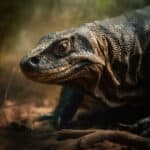Komodo dragons, the largest lizards on Earth, have long fascinated people with their impressive size and unique characteristics. These formidable creatures are native to the Indonesian islands of Komodo, Rinca, Flores, Gili Motang, and Padar, where they roam freely in their natural habitat. However, the question arises: are Komodo dragons endangered? The answer to this question is not a simple one. While these magnificent reptiles are currently listed as “vulnerable” by the International Union for Conservation of Nature (IUCN), there are concerns about their future survival due to various factors such as habitat loss, poaching, and climate change. In this article, we will delve deeper into the status of Komodo dragons and explore the challenges they face in the wild. So, let’s embark on a journey to discover the current state of these fascinating creatures and the efforts being made to protect them.
Key Takeaways
- Komodo dragons are classified as vulnerable by the International Union for Conservation of Nature (IUCN).
- Habitat loss, poaching, and climate change are the main threats to their survival.
- Conservation efforts are crucial to protect and preserve the remaining populations of Komodo dragons.
Understanding Komodo Dragons
A. Brief Overview of Komodo Dragons
Komodo dragons, scientifically known as Varanus komodoensis, are fascinating creatures that capture the imagination of many. These large reptiles are native to the Indonesian islands of Komodo, Rinca, Flores, Gili Motang, and Padar. They are the largest living lizards in the world, growing up to 10 feet long and weighing over 150 pounds. Despite their fearsome appearance, Komodo dragons are intriguing creatures with unique characteristics.
B. The Unique Habitat of Komodo Dragons
Komodo dragons inhabit a range of diverse habitats, including tropical forests, savannas, and grasslands. They are well-adapted to their environment, with their rugged, scaly skin providing protection from the harsh elements. These reptiles are excellent swimmers and can even cross short stretches of open water to reach neighboring islands.
One of the most remarkable aspects of Komodo dragons is their ability to survive in such a limited range. They are endemic to a few islands in Indonesia, with the majority of their population found within Komodo National Park. This park was established in 1980 to protect the species and its habitat. The park‘s diverse ecosystems, including lush forests and coastal areas, provide the perfect conditions for these reptiles to thrive.
C. The Biological Characteristics that Make Komodo Dragons Special
Komodo dragons possess several unique biological characteristics that set them apart from other reptiles. One of their most notable features is their venomous bite. While not all Komodo dragons are venomous, recent studies have revealed that their saliva contains toxic proteins that can cause severe damage to their prey. This venom, combined with their powerful jaws and sharp teeth, allows them to take down large animals such as deer and water buffalo.
Another fascinating aspect of Komodo dragons is their ability to reproduce through parthenogenesis. This means that females can lay fertile eggs without the need for fertilization by a male. While this method of reproduction is rare among vertebrates, it allows female Komodo dragons to ensure the survival of their species even in the absence of males.
Furthermore, Komodo dragons have a keen sense of smell, which they use to locate carrion from miles away. This ability, combined with their strong digestive system, allows them to consume large amounts of food in a short period. They are opportunistic hunters, feeding on a variety of prey, including birds, reptiles, and mammals.
In conclusion, Komodo dragons are remarkable creatures that have adapted to their unique habitat and possess several biological characteristics that make them special. Understanding these aspects of their biology is crucial for their conservation and protection. In the following sections, we will explore the challenges faced by Komodo dragons and the efforts being made to ensure their survival.
The Current Status of Komodo Dragons

A. The IUCN Red List Classification
The International Union for Conservation of Nature (IUCN) Red List is a comprehensive inventory of the conservation status of species worldwide. It serves as a crucial tool in assessing the vulnerability of different species, including the majestic Komodo dragons.
The Komodo dragon (Varanus komodoensis) is listed as “Vulnerable” on the IUCN Red List. This classification indicates that the species faces a high risk of extinction in the wild if appropriate conservation measures are not implemented.
B. The Population Trend of Komodo Dragons
The population trend of Komodo dragons is a matter of concern. The species has experienced a decline in numbers over the years. According to the IUCN, the population of Komodo dragons is estimated to be between 3,000 and 5,000 individuals. This relatively low number highlights the need for conservation efforts to protect these remarkable reptiles.
C. Threats Faced by Komodo Dragons
Komodo dragons face a range of threats that contribute to their endangered status. These threats include:
-
Habitat Loss: The destruction and degradation of their natural habitat pose a significant risk to Komodo dragons. Human activities such as deforestation, agriculture, and urbanization encroach upon their territories, reducing the available space for these reptiles to thrive.
-
Poaching and Animal Trafficking: Komodo dragons are highly sought after in the illegal wildlife trade. Their unique features and rarity make them valuable commodities. Poaching for their skins, bones, and body parts, as well as capturing them for the exotic pet trade, further exacerbates their population decline.
-
Climate Change Impact: The changing climate poses a threat to Komodo dragons and their habitat. Rising temperatures, sea-level rise, and extreme weather events can disrupt their ecosystems, affecting their food sources and nesting sites.
-
Ecosystem Disruption: The loss of biodiversity in the Komodo dragon’s habitat can have cascading effects on their survival. As apex predators, they play a crucial role in maintaining the balance of their ecosystems. Any disruption to this delicate balance can have far-reaching consequences.
Conservation efforts are essential to mitigate these threats and ensure the long-term survival of Komodo dragons. The Indonesian government, along with various organizations and stakeholders, is actively involved in protecting these endangered reptiles.
One notable conservation area is the Komodo National Park, a UNESCO World Heritage Site. This protected area spans several islands, providing a sanctuary for Komodo dragons and other wildlife. Strict regulations and monitoring help safeguard their habitat and combat illegal activities.
In conclusion, while Komodo dragons are currently classified as “Vulnerable” on the IUCN Red List, their population trend is declining, primarily due to habitat loss, poaching, climate change, and ecosystem disruption. It is crucial to continue conservation efforts and raise awareness about the importance of protecting these magnificent creatures and their unique habitat.
Factors Contributing to the Endangerment of Komodo Dragons
A. Habitat Destruction and Its Impact
One of the primary factors contributing to the endangerment of Komodo dragons is habitat destruction. As human populations expand and industries grow, the natural habitats of these magnificent creatures are being encroached upon and destroyed. This destruction has a significant impact on the Komodo dragon population, as it disrupts their ability to find food, reproduce, and establish territories.
The Komodo dragon, native to the Indonesian islands, particularly Komodo National Park, relies on a delicate balance of ecosystems for its survival. These reptiles inhabit a range of habitats, including tropical forests, savannas, and mangrove swamps. However, due to deforestation, urbanization, and agricultural expansion, these habitats are being rapidly destroyed. This loss of habitat not only reduces the available space for Komodo dragons but also leads to a decline in their prey species, such as deer, wild boar, and water buffalo.
B. Climate Change: A Silent Threat
Another silent threat to the Komodo dragon population is climate change. Rising temperatures, changing rainfall patterns, and increased frequency of extreme weather events pose significant challenges to the survival of these reptiles. As ectothermic creatures, Komodo dragons rely on their environment to regulate their body temperature. However, with climate change, the delicate balance of temperature and humidity that they depend on is being disrupted.
The warming climate affects the reproductive success of Komodo dragons. Higher temperatures can lead to skewed sex ratios, with more females being produced, which can result in reduced genetic diversity and hinder population growth. Additionally, changes in rainfall patterns can impact the availability of water sources, affecting the survival of both Komodo dragons and their prey.
C. Human Interference and Its Consequences
Human interference, including poaching and habitat disturbance, has severe consequences for the Komodo dragon population. Despite being protected by law and listed as a vulnerable species on the IUCN Red List, illegal poaching and animal trafficking continue to pose a significant threat to these reptiles. The demand for Komodo dragons in the exotic pet trade and traditional medicine markets drives this illegal activity.
Furthermore, human activities such as tourism and development in Komodo dragon habitats can disrupt their natural behaviors and cause stress. The presence of humans can disturb their feeding patterns, breeding habits, and overall well-being. It is crucial to strike a balance between promoting tourism and protecting the natural habitats of these endangered reptiles.
In conclusion, the endangerment of Komodo dragons is primarily driven by habitat destruction, climate change, and human interference. These factors, individually and collectively, pose significant risks to the survival of these magnificent creatures. Efforts must be made to conserve their habitats, raise awareness about the importance of protecting endangered species, and enforce strict regulations to combat illegal activities that threaten the Komodo dragon population. Only through collective action and conservation efforts can we ensure the long-term survival of these iconic reptiles and preserve the biodiversity of our planet.
The Role of Conservation Efforts

Conservation efforts play a crucial role in protecting endangered species and preserving biodiversity. In the case of Komodo dragons, these efforts are vital to ensure the survival of these magnificent creatures. Let’s explore the successful conservation stories, current strategies in place, and the importance of local community involvement in safeguarding the future of Komodo dragons.
A. Successful Conservation Stories
Over the years, there have been several success stories in Komodo dragon conservation. One notable example is the establishment of Komodo National Park in Indonesia. This protected area was established in 1980 and covers several islands, including Komodo Island, Rinca Island, and Padar Island. The park was created to safeguard the natural habitat of the Komodo dragon and other wildlife species.
Through the implementation of strict regulations and monitoring programs, Komodo National Park has been successful in protecting the Komodo dragon population. The park‘s rangers work tirelessly to prevent poaching and illegal wildlife trafficking, which are significant threats to the survival of these reptiles. As a result, the Komodo dragon population has stabilized, and their numbers have shown signs of recovery.
B. Current Conservation Strategies in Place
To ensure the long-term survival of Komodo dragons, various conservation strategies are currently in place. These strategies focus on addressing the primary threats faced by these reptiles, such as habitat loss and climate change impacts.
One of the key initiatives is the restoration and protection of Komodo dragon habitats. Efforts are being made to mitigate habitat destruction caused by human activities, such as deforestation and land conversion. By preserving their natural habitats, we can provide Komodo dragons with the necessary resources for survival and reproduction.
Additionally, research and monitoring programs are essential for understanding the population dynamics and behavior of Komodo dragons. These programs help scientists gather valuable data on their habitat requirements, breeding patterns, and overall health. Such information is crucial for developing effective conservation strategies and ensuring the long-term viability of the species.
C. The Importance of Local Community Involvement
Local community involvement is a vital component of successful Komodo dragon conservation. The people living in and around Komodo National Park play a significant role in protecting these endangered reptiles and their habitats.
Engaging local communities in conservation efforts helps raise awareness about the importance of preserving biodiversity and the unique ecological value of Komodo dragons. It also provides economic opportunities through eco-tourism, which incentivizes local communities to actively participate in conservation initiatives.
By involving local communities in decision-making processes and providing them with education and training, we can foster a sense of ownership and responsibility towards the conservation of Komodo dragons. This collaborative approach ensures that conservation efforts are sustainable and have long-lasting impacts.
In conclusion, the conservation efforts dedicated to protecting Komodo dragons have yielded positive results. Successful stories, such as the establishment of Komodo National Park, demonstrate the effectiveness of conservation strategies. However, ongoing efforts are necessary to address the existing and emerging threats faced by these magnificent reptiles. By involving local communities and implementing sustainable conservation strategies, we can secure a brighter future for the Komodo dragon and contribute to the preservation of our planet‘s biodiversity.
The Future of Komodo Dragons

A. Predicted Trends for Komodo Dragon Populations
As we look ahead to the future of Komodo dragons, it is crucial to assess the predicted trends for their populations. These magnificent reptiles, native to the Indonesian islands, are currently listed as vulnerable on the IUCN Red List. However, the future holds both challenges and opportunities for their survival.
One of the primary concerns for Komodo dragons is habitat loss. The rapid development and expansion of human activities in the Indonesian archipelago have led to the destruction of their natural habitats. This encroachment on their territory disrupts their ecosystems and threatens their survival. Without immediate action, the Komodo dragon population could face a significant decline.
Another factor that contributes to the endangerment of Komodo dragons is poaching. These reptiles are highly sought after in the illegal wildlife trade market. Their unique characteristics and rarity make them a target for collectors and animal traffickers. Poaching poses a severe threat to their population, as it disrupts their natural breeding patterns and reduces their numbers.
B. The Potential Impact of Continued Conservation Efforts
Despite the challenges they face, there is hope for the future of Komodo dragons. Conservation efforts play a vital role in protecting these endangered species and ensuring their survival. Organizations and governments are actively working towards implementing measures to safeguard their habitats and combat poaching.
One significant step in Komodo dragon conservation is the establishment of protected areas, such as the Komodo National Park. This park, located in Indonesia, serves as a sanctuary for these reptiles and other wildlife. It provides a safe haven where they can thrive without the threat of habitat destruction and poaching. By preserving their natural habitats, we can help maintain the delicate balance of biodiversity in the region.
Furthermore, conservation efforts also involve raising awareness among local communities and tourists. Education plays a crucial role in promoting sustainable practices and reducing the demand for illegal wildlife products. By educating people about the importance of preserving the Komodo dragon’s habitat and the consequences of poaching, we can foster a sense of responsibility and encourage positive change.
C. The Role of Education and Awareness in Conservation
Education and awareness are essential components of successful conservation efforts. By informing the public about the plight of Komodo dragons, we can inspire action and promote a sense of urgency. This can be achieved through various means, such as school programs, community initiatives, and public campaigns.
In schools, incorporating lessons about the importance of biodiversity and the conservation of endangered species can help instill a sense of responsibility in the younger generation. Teaching students about the unique characteristics and ecological significance of Komodo dragons can foster a deep appreciation for these reptiles and their habitats.
Community initiatives, such as workshops and awareness campaigns, can engage local residents in conservation efforts. By involving them in activities like habitat restoration and monitoring, we empower communities to take an active role in protecting the Komodo dragon population. This sense of ownership and pride can lead to long-term sustainability and support for conservation initiatives.
Public campaigns, both locally and internationally, can raise awareness about the threats faced by Komodo dragons. Through social media, documentaries, and news articles, we can reach a broader audience and encourage them to take action. By highlighting the importance of preserving these magnificent creatures, we can garner support for conservation efforts and secure a brighter future for Komodo dragons.
In conclusion, the future of Komodo dragons depends on our collective efforts to address the challenges they face. By predicting trends, implementing conservation measures, and promoting education and awareness, we can work towards ensuring the survival of these remarkable reptiles. Together, we can protect their habitats, combat poaching, and secure a future where Komodo dragons thrive in their natural environment.
Conclusion
In conclusion, the Komodo dragon, the largest lizard species in the world, is currently classified as a vulnerable species by the International Union for Conservation of Nature (IUCN). Despite being protected by law in Indonesia, the main threat to their survival is habitat loss due to human activities such as deforestation and agriculture. Additionally, illegal poaching and the introduction of invasive species also pose significant risks to their population. Conservation efforts, including the establishment of protected areas and education programs, are crucial in ensuring the long-term survival of these fascinating creatures. It is essential that we continue to raise awareness about the importance of preserving the natural habitats of the Komodo dragon and take action to protect this iconic species for future generations.
Frequently Asked Questions
What is the current status of Komodo dragons on the IUCN Red List?
Komodo dragons are currently classified as ‘Vulnerable’ on the IUCN Red List. This means that they are at high risk of endangerment in the wild due to various factors such as habitat loss, poaching, and climate change impact.
How does habitat loss affect Komodo dragons?
Habitat loss is a significant threat to Komodo dragons. As human activities encroach on their natural habitats in Indonesian wildlife, these dragons lose their homes and hunting grounds, leading to a decline in their population.
What are the main threats to Komodo dragon conservation?
The main threats to Komodo dragon conservation include habitat loss due to human activities, poaching for the illegal wildlife trade, and climate change impact which can alter and disrupt their natural habitats.
How does poaching contribute to the endangerment of Komodo dragons?
Poaching contributes significantly to the endangerment of Komodo dragons. These creatures are often hunted for their skin and other body parts, which are sold illegally in the animal trafficking market. This not only reduces their population but also disrupts the biodiversity of their ecosystem.
What is the role of Komodo National Park in Komodo dragon conservation?
Komodo National Park plays a crucial role in Komodo dragon conservation. It provides a protected habitat for these endangered reptiles, safeguards them from poaching, and conducts various conservation efforts to ensure their survival and population growth.
How does ecosystem disruption affect Komodo dragons?
Ecosystem disruption can have a significant impact on Komodo dragons. Changes in their habitat, caused by factors such as climate change or human activities, can lead to a lack of food and shelter, increased competition for resources, and higher vulnerability to predators, all contributing to their population decline.
What is the extinction risk for Komodo dragons?
The extinction risk for Komodo dragons is high due to various environmental threats like habitat loss, poaching, and climate change. If these threats are not addressed, these unique creatures may face a severe population decline or even extinction.
How does biodiversity loss affect Komodo dragons?
Biodiversity loss can have a significant impact on Komodo dragons. A diverse ecosystem provides a balanced food chain and a healthy environment for these creatures. Loss of biodiversity can disrupt this balance, leading to a lack of food and increased competition for resources, thereby threatening their survival.
What are some of the conservation efforts for Komodo dragons?
Conservation efforts for Komodo dragons include establishing and enforcing protected areas like Komodo National Park, implementing anti-poaching laws, conducting research on their population and habitat, and raising awareness about their plight.
How does climate change impact the Komodo dragon habitat?
Climate change can severely impact the Komodo dragon habitat. Rising temperatures and sea levels, changing rainfall patterns, and increased frequency of extreme weather events can alter their natural habitats, disrupt their food sources, and increase their vulnerability to diseases, thereby threatening their survival.




